![]()
![]()
![]()
Use LEFT and RIGHT arrow keys to navigate between flashcards;
Use UP and DOWN arrow keys to flip the card;
H to show hint;
A reads text to speech;
301 Cards in this Set
- Front
- Back
|
Designated Agent
|
An EMT or other person authorized by a Medical Director to give medications and provide emergency care.
|
|
|
EMS System
|
A system designed to get trained personnel to the patient as quickly as possible and to proivide emergency care on the scene, en route to the hospital, and in the hospital.
|
|
|
Enabling Legislation
|
State laws that allow the EMS system to exist.
|
|
|
Enhanced 911
|
A communications system that has the capability of automatically identifying the caller's phone number and location.
|
|
|
Medical Direction
|
The provision for physician input and direction of patient care, training, and quality assurance of an emergency medical service system.
|
|
|
Medical Director
|
A physician who assumes the ultimate responsibility for the patient-care aspects of the EMS system.
|
|
|
911 System
|
A system for telephone access to report emergencies in which a dispatcher answers the call, takes the information, and alerts EMS or the fire or police departments as needed.
|
|
|
Protocols
|
Lists of steps, developed by the Medical Director of an EMS system, that are to be taken in different situations.
|
|
|
Quality Improvement
|
A process of continuous self-review with the purpose of identifying and correcting aspects of the system that require improvement.
|
|
|
Standing Order
|
Policy or protocol issued by a Medical Director that authorizes EMTs or others to perform particular skills in certain situations.
|
|
|
The earliest documented emergency medical service was in:
|
France in the 1790's.
|
|
|
In 1966, the ______ charged the United States ______ with developing EMS standards.
|
National Highway Safety Act, Department of Transportation
|
|
|
What are the components in the National Highway Traffic Safety Administration's EMS system assessment standards?
|
Regulation and Policy
Resource Management Human Resources and Training Transportation Facilities Communications Public Information and Information Medical Direction Trauma Systems Evaluation |
|
|
What are examples of specialty hospitals?
|
Trauma Centers
Burn Centers Cardiac Centers Pediatric Centers Stroke Centers Poison Control Centers |
|
|
What are the National Levels of EMS training?
|
First Responder/Emergency Medical Responder
EMT-Basic/EMT EMT-Intermediate/Advanced EMT EMT-Paramedic/Paramedic |
|
|
The major emphasis of the curriculum for the EMT deals with ______ of the ill or injured patient in the prehospital setting.
|
assessment and care
|
|
|
Patient care provided by the EMT should be:
|
based on assessment findings.
|
|
|
List ways an EMT can assure continuity during the transfer of care of the patient.
|
Providing pertinent patient information to the hospital staff.
Patient Advocacy. |
|
|
Patient Advocacy is:
|
Speaking up for your patient.
|
|
|
What are some good personality traits you should have as an EMT?
|
Pleasent
Sincere Cooperative Resourceful A self-starter Emotionally Stable Able to Lead Neat and Clean Of good moral character and respectful of others In control of personal habits Controlled in conversation and able to communicate properly Able to listen to others Non-judgemental and fair |
|
|
If an EMT is not in control of personal habits, he or she might:
|
Contaminate the patient's wounds,
Make inappropriate decisions, or Render improper care. |
|
|
To help prevent violating patient confidentiality, the EMT should:
|
Avoid inappropriate conversation, and be respectful of how you would like to be treated if you were th patient.
|
|
|
What are the ways in which an EMT may further his or her EMS education?
|
Attending EMS conferences and/or seminars,
Refresher training, Continuing Education |
|
|
A process of continuous self-review of all aspects of an EMS system for the purpose of identifying and correcting aspects of the system that require improvement is called:
|
Quality Improvement
|
|
|
Obtaining feedback from patients and the hospital staff is a means of:
|
Providing quality improvement.
|
|
|
Participation in continuing education and keeping carefully written documentation are examples of the EMT's role in:
|
Quality Improvement
|
|
|
Every EMS system should have a:
|
Medical Director
|
|
|
An EMT is operating as the Medical Director's:
|
Designated Agent
|
|
|
What is the difference between on-line (direct) and off-line (indirect) medical direction?
|
On-line orders are given by the on-duty physician, usually over the radio or phone, while off-line orders are standing orders that an EMT is allowed to do without contacting the Medical Director.
|
|
|
What is a common medication carried by EMTs that may require a physician consultation to administer?
|
Activated Charcoal
|
|
|
Participating in injury prevention would be an example of:
|
A Community Health Initiative
|
|
|
It is the responsibility of the EMT to treat patients:
|
in a nonjudgmental and fair manner.
|
|
|
Deciding which hospital to transport to is an example of ______ that is within the practice of the EMT.
|
clinical decision making
|
|
|
In the near future, the designation "First Responder" will be changed to:
|
Emergency Medical Responder
|
|
|
Anger
|
When a patient puts off dealing with the inevitable end of the process of dying.
|
|
|
Bargaining
|
When a patient mentally tries to postpone death for a short time
|
|
|
Biohazard
|
A potentially infectious material
|
|
|
Body Substance Isolation (BSI)/Standard Precautions
|
A form of infection control based on the presumption that all body fluids are infectious
|
|
|
Critical Incident Stress Management (CISM) teams
|
Mental health professionals and peer counselors who work as a team to provide emotional and psychological support to EMS personnel who are or have been involved in a highly stressful incident.
|
|
|
Decontamination
|
The removal or cleansing of dangerous chemicals or other dangerous or infectious materials
|
|
|
Denial
|
When a patient puts off dealing with the inevitable end of the process of dying
|
|
|
Stress
|
A state of physical and/or psychological arousal to a stimulus
|
|
|
Hazardous-Materiat Incident
|
The release of a harmful substance into the environment
|
|
|
HEPA
|
A high-efficiency particulate air respirator or mask designed to reduce the spread of tuberculosis (TB)
|
|
|
Immunizations
|
Injections given to a rescuer that are designed to prevent him or her from getting a disease
|
|
|
MCI
|
An emergency involving multiple patients
|
|
|
Pathogens
|
The organisms that cause infection, such as viruses and bacteria
|
|
|
Personal Protective Equipment (PPE)
|
Equipment that protects the EMS worker from infection and/or from hazardous materials and the dangers of rescue operations.
|
|
|
PPD test
|
Test that determines if a person has been exposed to TB
|
|
|
The most critical job of the EMT is to:
|
stay physically safe and emotionally well
|
|
|
An organism that causes infection is referred to as a(n):
|
pathogen
|
|
|
Precautions the EMT should take when dealing with all patients are known as:
|
standard precautions
|
|
|
Disposable gloves and eye protections are considered:
|
Body Substance Isolation (BSI)
|
|
|
An EMT should routinely wear a mask when treating a patient with:
|
potential for blood or fluid splatter.
|
|
|
When an EMT covers a patient's mouth and nose with a mask to prevent the spread of an airborne disease, he or she should:
|
monitor the respirations and airway closely.
|
|
|
List some ways an EMT can plan safety precautions in advance of the call:
|
Keeping immunizations current, obtaining the hepatitis B vaccine, and verifying immune status.
|
|
|
What vaccines is it suggested that all EMTs be immunized with?
|
Tetanus,
Hepatitis B or C, Measles |
|
|
A federal organization responsible for issuing guideline for employee safety around biohazards is called the:
|
Occupational Safety and Health Administration
|
|
|
Every employer of EMTs must provide free of charge:
|
a hepatitis B vaccination
|
|
|
A federal act that establishes procedures by which emergency response workers can find out if they have been exposed to life-threatening infectious diseases is:
|
Ryan White CARE Act
|
|
|
After contact with the blood or body fluids of a patient, an EMT may submit a request for a determination of exposure to his or her:
|
designated officer
|
|
|
Always assume that any person with a productive cough has:
|
TB
|
|
|
What should you do if, as an EMT, you need to treat a contaminated patient at a hazardous-material incident?
|
Delay treatment until the patient is decontaminated.
|
|
|
The EMT can safeguard his or her well-being by:
|
Understanding and dealing with job stress,
ensuring scene safety, and practicing body substance isolation (BSI) |
|
|
What calls have a high potential for causing excess stress on an EMS provider?
|
Calls involving infants and children,
Multiple-casualty incidents, severe injuries, abuse and neglect, or death of a coworker. |
|
|
What are some warning signs of stress?
|
Irritability,
Anxiety, Indecisiveness, Guilt, Loss of interest in sex, Isolation, Loss of interest in work |
|
|
What are some recommended lifestyle changes an EMT may take to deal with job stress?
|
Develop more helthful and positive dietary habits,
devote time to relaxation, exercise, increase carb, balance work, family, and recreation. |
|
|
A meeting held by a team of peer counselors and mental health professionals within 24 to 72 hours after a major incident is a(n):
|
CISD, critical incident stress debriefing
|
|
|
What are rules that must be followed to make CISM effective?
|
It must NOT be an investigation of the events of the call,
information discussed must remain confidential, and an EMT must feel open to discuss feelings, fears, and reactions. |
|
|
What can participating in a CISM accomplish for the EMS provider who had just worked a high-stress job?
|
It can accelerate the recovery process.
|
|
|
List the five stages of death or dying:
|
Denial or "Not me..."
Anger or "Why me?" Bargaining or "Okay, but first let me..." Depression or "Okay, but I haven't..." Acceptance or "Okay, I'm not afraid." |
|
|
What are steps/approaches in dealing with the patient and family members confronted with death or dying?
|
Recognize the patients needs,
Be tolerant of angry reactions fromn the patien or family members, Listen empathetically, Do NOT falsely reassure, Offer as much comfort as you realistically can. |
|
|
What are the three R's of reacting to danger?
|
Retreat,
Radio, Reevaluate |
|
|
The body's response to stress was studied by Dr. Hans Selye, who found there is a(n):
|
general adaptation syndrome
|
|
|
What are the three phases of adaption to stress?
|
Alarm,
Exhaustion, Resistance |
|
|
A stress reaction that involves either physical or psychological behavior manifested days or weeks after an incident is called a(n):
|
post-traumatic stress disorder
|
|
|
The Centers for Disease Control and Prevention recommends the use of ______ when soap and water are not immediately available to help kill microorganisms on a rescuer's hands.
|
Alcohol-based hand cleaners
|
|
|
The normal mode of transmission of the disease chicken pox (varicella) is thought to be:
|
airborne droplets
|
|
|
Bacterial meningitis, pneumonia, and tuberculosis are though to be spread by:
|
respiratory secretions or oral or nasal secretions.
|
|
|
A disease that mother are thought to be able to pass to their unborn child is:
|
AIDS
|
|
|
The critical elements of the infection control plan required by Title 29 Code of Federal Regulation 1910.1030 are:
|
Infection exposure control plan,
adequate education and training, hepatitis B vaccination, personal protective equipment, methods of control, housekeeping, labeling, and postexposure evaluation and follow-up. |
|
|
Implied Concent
|
Permission to treat an unconscious patient until he or she becomes conscious
|
|
|
Advance Directive
|
A written order given by the physician based upon a decision by a patient prior to his or her demise; instructions written in advance of an event
|
|
|
Liability
|
Being held legally responsible
|
|
|
Duty to Act
|
An obligation to provide care to a patient
|
|
|
Expressed Concent
|
Permission given by adults who are of legal age and mentally competent to make a rational decision in regard to their medical well-being
|
|
|
Consent
|
Permission from the patient to treat him or her
|
|
|
Good Samaritan Laws
|
A series of laws, varying in each state, designed to provide limited legal protection for citizens and some health care personnel who are administering emergency care
|
|
|
Scope of Pracice
|
The collective medical, legal, and ethical guidelines that govern the EMT
|
|
|
Breach of Duty
|
Not providing the standard of care
|
|
|
Negligence
|
A finding of failure to act properly in a situation in which there was a duty to act
|
|
|
DNR Order
|
A legal document, usually signed by the patient and his or her physician, which states that the patient does not wish to prolong life through resuscitative efforts
|
|
|
Confidentiality
|
The obligation not to reveal information obtained about a patient except to other health care professionals involved in the patient's care, or under subpoena, or in a court of law
|
|
|
Abandonment
|
Leaving a patient after care has been initiated and before the patient has been transferred to someone with equal or greater medical training
|
|
|
Emancipated Minor
|
Child who is married or of a specific age who, in certain states, can make legal decisions
|
|
|
Battery
|
Subjecting a patient to unwanted care and transport may be considered this in a court of law
|
|
|
HIPAA
|
A federal law protecting the privacy of patient-specific health care information
|
|
|
The collective set of regulation and ethical considerations governing the EMT is called:
|
Scope of practice
|
|
|
Legislation that governs the skills and medical interventions that may be performed by an EMT is:
|
different from state to state.
|
|
|
When the EMT makes the physical/emotional needs of the patient a priority, this is considered a(n) ______ of the EMT.
|
ethical responsibility
|
|
|
What are the types of consent?
|
Implied
Expressed |
|
|
When you inform the adult patient of a procedure you are about to perform and its associated risks, you are looking for:
|
expressed consent
|
|
|
Concent that is based on the assumption that an unconscious patient would approve the EMT's life-saving interventions is called:
|
Implied consent
|
|
|
What should your record of a patient's refusal of medical aid or transport include?
|
Informing the patient of the risks and consequences of refusal,
documenting the steps you took, and, obtaining a release form with the patient's witnessed signature. |
|
|
Forcing a competent adult patient to go to the hospital against his or her will may result in ______ charges against the EMT.
|
assult and battery
|
|
|
What are some of the actions you should take if a patient refuses care?
|
Leave phone stickers with emergency numbers, recommend that a relative call the family physician to report the incident, call a relative or neighbor who can stay with the patient
|
|
|
Another name for a DNR order is:
|
advanced directive
|
|
|
Why are there varying types of DNR orders?
|
Because for some patients they would like to be given CPR or other life-saving treatment only if certain things were to tak place, like the EMT were to see cardiac arrest, etc.
|
|
|
In a hosptial, long-term life-support and comfort care measures would consist of intravenous feeding and:
|
the use of a respirator
|
|
|
If an EMT with a duty to act fails to provide the standard of care, and if this failure causes harm or injury to the patient, the EMT may be accused of:
|
Negligence
|
|
|
Termination of care of the patient without assuring the continuation of care at the same level or higher is called:
|
Abandonment
|
|
|
What information that you gain about a patient is confidential?
|
patient history gained through interview,
assessment findings, treatment rendered. |
|
|
What are the circumstances that have to be met for the EMT to release patient confidentiality?
|
Inform other health care professionals who need to know information to continue care,
report incidents required by state law, such as rape or abuse, comply with a legal subpoena. |
|
|
What may a medical insignia come on?
|
bracelets,
necklaces, cards. |
|
|
When treating a critical patient who has an organ donor card, the EMT should:
|
treat the patient the same as any other patient and inform the ED physician.
|
|
|
What are some things an EMT should be aware of at a crime scene?
|
Remember what you touch,
minimize your impact on the scene, work with the police. |
|
|
Situations that are commonly required to report are:
|
Child and elder abuse,
sexual assult, domestic abuse |
|
|
The federal law designed to protect the patient's private medical information is the:
|
HIPAA
|
|
|
An agency privacy office is required by the:
|
Health Insurance Portability and Accountability Act.
|
|
|
What are some examples of microscopic evidence?
|
dirt and carpet fibers.
|
|
|
What are the four conditions required for a patient to refuse care?
|
Patient must be leagally able to consent
patient ust be mentally competent and oriented patient must be fully informed patient must sign a "release" form |
|
|
A finding of negligence, or failure to act properly, requires that all of the following circumstances be proven:
|
The EMT had a duty to the patient (duty to act),
The EMT did not provide the standard of care (committed a breach of duty). This may include failure to act. By not providing the standard of care, the EMT caused harm to the patient. This harm could be physical or emotional. (Proximat cause) Omission--didn't do it, should have Comission--did it, shouldn't have |
|
|
What are some conditions that may be listed on a medical identification device (such as necklace, bracelet, or card)?
|
Diabeties,
Heart Problems, Allergies, Epilepsy |
|
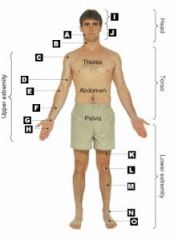
|
A. Mandible
B. Neck C. Shoulder D. Arm E. Elbow F. Forearm G. Wrist H. Hand I. Cranium J. Face K. Thigh L. Knee M. Leg N. Ankle O. Foot |
|
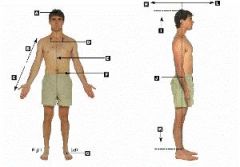
|
A. Midline
B. Proximal C. Distal D. Mid-clavicular E. Medial F. Lateral G. Dorsal H. Posterior (dorsal) I. Superior J. Mid-axillary K. Inferior L. Anterior (ventral) |
|
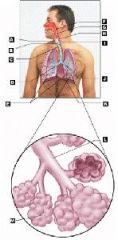
|
A. Thyroid Cartilage
B. Cricoid Cartilage C. Trachea D. Right Main Bronchus E. Lungs F. Nasopharynx G. Oropharynx H. Epiglottis I. Larynx J. Left Main Bronchus K. Diaphragm L. Bronchiole M. Alveolus |
|
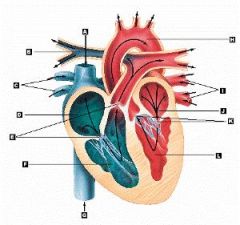
|
A. Superior Vena Cava
B. Right Pulmonary Artery C. Right Pulmonary Vein D. Right Atrium E. Tricuspid Vavles F. Right Ventricle G. Inferior Vena Cava H. Aorta I. Left Pulmonary Veins J. Left Atrium K. Bicuspid Vavles L. Left Ventricle |
|
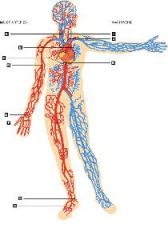
|
A. Carotid
B. Pulmonary Artery C. Aorta D. Brachial E. Radial F. Femoral G. Posterior tibial H. Dorsal pedis I. Pulmonary vein J. Superior vena cava K. Inferior vena cava |
|
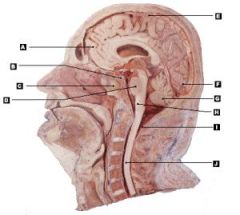
|
A. Frontal lobe
B. Pituitary gland C. Sphenoidal sinus D. Pons E. Meningrs F. Occipital lobe G. Cerebellum H. Medulla oblongata I. Dura mater J. Spinal cord |
|

|
A. Suprasternal (jugular) notch
B. Clavicle C. Sternum D. Diaphragm E. Umbilicus F. Sternoclavicular joint G. Thorax region H. Xiphoid Process I. Costal Arch (margin) J. Pubis K. Scapular region L. Lumbar region M. Illiac crest |
|
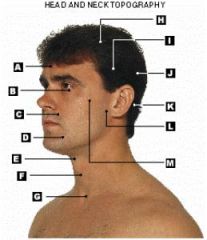
|
A. Frontal region
B. Orbit C. Maxilla D. Mandible E. Larynx F. Trachea G. Suprasternal (jugular) notch H. Pariental region I. Temporal region J. Occipital region K. Mastoid process L. Temporo-mandibular joint M. Zygomatic region |
|
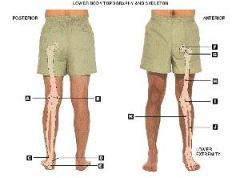
|
A. Lateral femoral condyle
B. Medial femoral condyle C. Lateral malleolus D. Medial malleolus E. Calcaneus F. Femoral head G. Femoral neck H. Shaft of femur I. Patella J. Fibula K. Tibia |
|
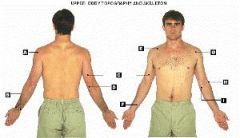
|
A. Humeral head
B. Radial and ulnar styloids C. Shaft of humerus D. Elbow E. Acromioclavicular joint F. Ulnar Shaft G. Glenohumeral joint H. Lateral humeral condyle I. Medial humeral condyle |
|
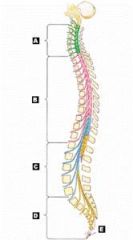
|
A. Cervical (7)
B. Thoracic (12) C. Lumbar (5) D. Sacral (5) E. Coccyx (4) |
|
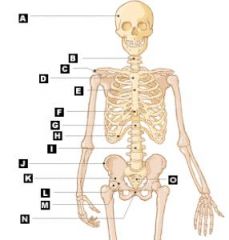
|
A. Skull
B. Cervical spine (neck) C. Acromion process D. Manubrium E. Sternum (breast bone) F. Xiphoid process G. Thoracic spine H. Costal cartilage I. Lumbar spine J. Ilium K. Pelvis L. Femur head M. Acetabulum N. Pubis O. Sacral spine |
|
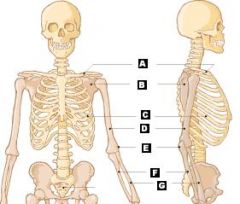
|
A. Clavicle (collarbone)
B. Scapula (shoulder blade) C. Ribs D. Humerus E. Elbow F. Ulna G. Radius |
|
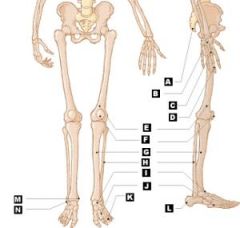
|
A. Coccyx (tail bone)
B. Carpals (wrist) C. Metacarpals (hand) D. Phalanges (fingures) E. Femur (thigh bone) F. Patella (knee cap) G. Tibia H. Fibula I. Tarsals (ankle) J. Metatarsals (foot) K. Phalanges (toes) L. Calcaneus (heel) M. Medial malleolus N. Lateral malleolus |
|
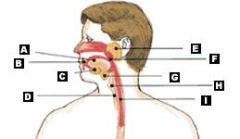
|
A. Tongue
B. Teeth C. Sublingual Gland D. Trachea E. Parotid Gland F. Pharynx G. Submaxillary Gland H. Larynx I. Esophagus |
|

|
A. Liver
B. Gallbladder C. Cystic Duct D. Common Bile Duct E. Duodenum F. Hepatic Flexure G. Ascending Colon H. Ileocecal valve I. Cecum J. Appendix K. Rectum |
|

|
A. Cardiac Spincter
B. Spleen C. Stomach D. Bile Ducts E. Splenic Flexure F. Pyloric Sphincter G. Pancreas H. Transverse Colon I. Decending Colon J. Ileum K. Sigmoid Colon L. Anus |
|
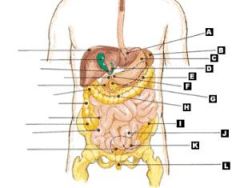
|
A. Cardiac Spincter
B. Spleen C. Stomach D. Bile Ducts E. Splenic Flexure F. Pyloric Sphincter G. Pancreas H. Transverse Colon I. Decending Colon J. Ileum K. Sigmoid Colon L. Anus |
|
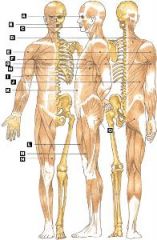
|
A. Orbicularis Oculi
B. Masseter C. Orbicularis Oris D. Trapezius E. Deltoid F. Pectoralis G. Triceps H. Serratus I. Anterior Biceps J. Lattisimus Dorsi K. Rectus Abdominis L. Rectus Femoris M. Vastus Lateralis N. Vastus Medialis O. Gluteus Maximus |
|
|
What are the three types of muscles?
|
Voluntary, aka Skeletal
Involuntary, aka Smooth Cardiac |
|
|
Voluntary Muscle
|
Muscle that can be consciously controlled. Skeletal muscle
|
|
|
Involuntary Muscle
|
Muscle that responds automatically to brain signals but cannot be consciously controlled. Smooth muscle
|
|
|
Cardiac Muscle
|
Specialized involuntary muscle found only in the heart.
|
|
|
Bronchi
|
Main branch of the respiratory system that enters each of the lungs.
|
|
|
Atria
|
Two upper chambers of the heart.
|
|
|
Diaphragm
|
Muscle that divides the chest cavity from the abdominal cavity.
|
|
|
Femoral Pulse
|
The carotid and this pulse are consdidered central pulses.
|
|
|
Capillaries
|
Tiny blood vessels
|
|
|
Carotid Pulse
|
Pulse in the neck at the side of the larynx
|
|
|
Cardiovascuar System
|
Body system that transports blood throughout the body
|
|
|
Oropharynx
|
Area directly posterior to the mouth
|
|
|
Brachial Pulse
|
Pulse in the arm used to take a blood pressure
|
|
|
Nasopharynx
|
Area directly posterior to nose
|
|
|
Cricoid Cartilage
|
Ring-shaped structure that forms the lower larynx
|
|
|
Larynx
|
Structure that contains the vocal cords
|
|
|
Epiglottis
|
Leaf-shaped structure that closes to prevent food from going into the trachea
|
|
|
Dorsalis Pedis Pulse
|
Pulse on the top of the foot lateral to the large tendon of the big toe
|
|
|
Arteries
|
Vessels that carry blood away from the heart
|
|
|
Pharynx
|
Area posterior to the mouth and nose that includes the oropharynx and nasopharynx
|
|
|
Platelets
|
Parts of the blood needed to form blood clots
|
|
|
Plasma
|
Watery, salty fluid that makes up over half of the blood's volume
|
|
|
Posterior Tibial Pulse
|
Pulse that may be palpated on the posterior aspect of the medial malleolus
|
|
|
Trachea
|
Structure that carries ihaled air from the larynx to the lungs; also called the windpipe
|
|
|
Veins
|
Vessels that carry blood from the capillaries back to the heart
|
|
|
Systolic
|
Blood pressure created in the arteries when the left ventricle contracts and forces blood out into circulation
|
|
|
Respiratory System
|
Body system that takes in oxygen and eliminates carbon dioxide
|
|
|
Acetabulum
|
Socket that holds the ball of the proximal femur to form the hip
|
|
|
Ventricles
|
The two lower chambers of the heart
|
|
|
Involuntary Muscle
|
Muscle type that responds automatically without the patient thinking about its operation
|
|
|
Venae Cavae
|
Two large viens that return blood to the heart
|
|
|
Femur
|
Long bone of the thigh
|
|
|
Radial Pulse
|
Pulse on the thunmb side of the wrist
|
|
|
Fibula
|
The smaller bone of the lower leg
|
|
|
Pubis
|
Medial anterior portion of the pelvis
|
|
|
Sacral Spine
|
Vertebrae that form the back of the pelvis
|
|
|
Anatomical Position
|
Standing face forward with palms forward
|
|
|
Coccyx
|
Inferior-most division of the spine that is referred to as the tailbone
|
|
|
Medial
|
Toward or closer to the midline
|
|
|
Mandible
|
Lower jaw bone
|
|
|
Medial Malleolus
|
Round ball of bone on the inside of the ankle
|
|
|
Iliac Crest
|
Wide bony ring that can be felt near the waist
|
|
|
Peripheral Nervous System
|
System that consists of sensory and motor nerves
|
|
|
Lateral Malleolus
|
Round ball of bone on the outside of the ankle
|
|
|
Orbit
|
Facial bone that surrounds each of the eyes
|
|
|
Sternum
|
Breastbone
|
|
|
Cervical Spine
|
Seven vertebrae in the neck
|
|
|
Tarsals
|
Bones of the ankle
|
|
|
Tibia
|
Medial and larger of the two bones of the lower leg
|
|
|
Xiphoid Process
|
Inferior tip of the sternum
|
|
|
Humerus
|
Upper arm bone
|
|
|
Lateral
|
Away from the midline
|
|
|
Sensory Nerves
|
Nerves that transmit information from the body to the spinal cord and brain
|
|
|
Proximal
|
When two points on the extremities are compared, the point closer to the torso
|
|
|
Epidermis
|
Outermost layer of the skin
|
|
|
Distal
|
When two points on the extremities are compared, the point farther away from the torso
|
|
|
Motor Nerves
|
Nerves that carry messages from the brain to the body
|
|
|
Superior
|
Above or toward the head end of the torso
|
|
|
Dermis
|
Inner layer of the skin in which blood vessels and nerves are located
|
|
|
Phalanges
|
Bones in the fingers and toes
|
|
|
Elbow
|
Joint where three bones of the upper arm and forearm are connected
|
|
|
Anterior
|
Front side of the body or body part
|
|
|
Calcaneus
|
Heel bone
|
|
|
Posterior
|
Back side of the body or body part
|
|
|
Endocrine System
|
Body system that regulates metabolic functions such as sugar absorption by cells
|
|
|
Nervous System
|
Body system that governs sensations, movement, and thought
|
|
|
Radius
|
Lateral bone of the forearm aligned with the thumb
|
|
|
Metacarpals
|
Bones that make up the hand
|
|
|
Acromion Process
|
Highest portion of the shoulder
|
|
|
Ulna
|
Medial bone of the forearm
|
|
|
Carpals
|
Bones that make up the wrist
|
|
|
Scapula
|
Shoulder blade
|
|
|
Clavicle
|
Bone in the front of the shoulder or collarbone
|
|
|
Torso
|
The body less the extremities and the head
|
|
|
Supine
|
Lying on the back
|
|
|
Mid-clavicular
|
An imaginary line drawn vertically from the center of the clavicle to the nipple below
|
|
|
Flowler's
|
The sitting position
|
|
|
Bilaterally
|
Similar on both sides of the body
|
|
|
Trendelenburg
|
Lying supine with the legs elevated a few inches
|
|
|
Voluntary Muscle
|
Muscle under conscious control of the brain. AKA skeletal muscle
|
|
|
Abdominal quadrants
|
Four divisions of the abdomen used to pinpoint the location of pain
|
|
|
Plantar
|
Referring to the sole of the foot
|
|
|
Coronary Arteries
|
Blood vessels that supply the muscle of the heart
|
|
|
Dorsal
|
Referring to the back of the body
|
|
|
Maxilla
|
Upper jaw bone
|
|
|
Musculoskeletal System
|
Body system that provides protection and movement
|
|
|
Diastolic
|
Blood pressure in the arteries when the left ventricle is refilling
|
|
|
Patella
|
Kneecap
|
|
|
Lumbar Spine
|
Vertebrae of the lower back
|
|
|
Thoracic Spine
|
Rib area of the spinal column
|
|
|
Midline
|
Imaginary line drawn vertically through the middle of the body
|
|
|
Axilla
|
Anatomical term for the armpit
|
|
|
Left Side
|
Patient's left side
|
|
|
Prone
|
Lying on the stomach or face down
|
|
|
List the body systems:
|
Cardiovascular System,
Digestive System, Endocrine System, Musculoskeletal System, Respiratory System |
|
|
If a patient is lying on his or her left side, this position is called the ______ position.
|
Recovery
|
|
|
When a patient is placed in a sitting-up position on a stretcher, this position is called:
|
Fowler's.
|
|
|
When a patient is lying flat with head lower than legs, this position is called:
|
Trendelenburg.
|
|
|
The musculoskeletal system has three main functions. It gives the body shape, provides for body movements, and:
|
Protects vital internal organs.
|
|
|
The upper jaw is also called the:
|
Maxillae
|
|
|
What are the divisions of the spine?
|
Cervical (neck) 7
Thoracic (thorax, ribs, upper back) 12 Lumbar (lower back) 5 Sacral (back wall of pelvis) 5 Coccyx (tailbone) 4 *Thoracic, Sacral, and Coccyx are LESS likely to injure because they are better protected than the Cervical and Lumbar |
|
|
An injury to the spinal cord at the ______ level may be fatal because control of the muscles of breathing arise from the spinal cord at this level.
|
Cervical
|
|
|
Femur, Calcaneus and Phalanges are bone in the ______ extremities.
|
Lower
|
|
|
Humerus and Radius are bones in the ______ extremities.
|
Upper
|
|
|
The type of muscle that allows body movement such as walking is called:
|
Voluntary
|
|
|
In the walls of the blood vessels you find ______ muscles.
|
Involuntary, or smooth
|
|
|
The structure in the throat that is describes as the voicebox is called the:
|
Larynx
|
|
|
A leaf-shaped valve that prevent food and foreign objects from entering the trachea is called the:
|
Epiglottis
|
|
|
In what order does oxygen pass from the environment to the lungs?
|
Mouth, pharynx, trachea, bronchi, alveoli
|
|
|
When the diaphragm and intercostal muscles relax, the chest cavity:
|
Decreases, causing exhalation
|
|
|
What is the main difference between an adult and child airway?
|
All structures are smaller and more easily obstructed in a child.
|
|
|
The body system responsible for the breakdown of food into absorbable forms is called the ______ system.
|
Digestive
|
|
|
An organ containing acidic gastric juices that begin the breakdown of food into components that the body will be able to convert to energy is the:
|
Stomach
|
|
|
The major artery in the thigh is called the:
|
femoral
|
|
|
The ______ receives blood from the pulmonary veins.
|
left atrium
|
|
|
The fluid that carries blood cells and nutrients is called:
|
Plasma
|
|
|
The blood component that is essential to the formation of blood clots is called:
|
Platelets
|
|
|
The pressure on the walls of an artery when the left ventricle contracts is called the ______ pressure.
|
Systolic
|
|
|
The two main divisions of the nervous system are:
|
Central and Peripheral
|
|
|
Nerves that carry information from throughout the body to the brain are _______ nerves.
|
Sensory
|
|
|
What are the functions of the skin?
|
Protection
Water balance Temperature regulation Excretion Shock (impact) absorption |
|
|
The system that secretes hormones, such as insulin and adrenaline, and which is responsible for regulating many body activities, is called the ______ system.
|
Endocrine
|
|
|
List the name of nine arteries in the body:
|
Carotid
Pulmonary Artery Aorta Brachial Radial Femoral Posterior Tibial Dorsal Pedia |
|
|
Basket Stretcher
|
Stretcher, made of a steel wire mesh and tubular steel rim or plastic and steel rim, used to transport patient from one level to another or over rough terrain.
|
|
|
Stair Chair
|
Portable folding chair with wheels used to transport the patient in a sitting position up or down stairs.
|
|
|
Scoop (orthopedic) Stretcher
|
Stretcher that splints in halves, which can be pushed together under the patient.
|
|
|
Direct Carry
|
Method of transferring a patient from bed to stretcher during which two or more rescuers curl the patient to their chests, then reverse the process to lower the patient to the stretcher.
|
|
|
What increased are seen with vWF disease?
|
increased BT, with PTT elongation, positive ristocetin
|
|
|
Extremity Lift
|
Method of lifting and carrying a patient in which one rescuer slips hands under the patient's armpits and grasps the wrists, while another rescuer grasps the patient's knees.
|
|
|
Power Lift
|
Made from a quatting position with weight to be lifted close to the body, feet apart and flat on the ground, body weight on or just behind balls of feet, back locked in.
|
|
|
Body Mechanics
|
Proper use of the body to facilitate lifting and moving and to prevent injury
|
|
|
Power Grip
|
Gripping with as much hand surface as possible the object being lifted, with all fingers bent at the same angle
|
|
|
Urgent Move
|
Patient move that should be done quickly yet without any compromise of spinal integrity
|
|
|
Draw-Sheet Method
|
Method of transferring a patient from bed to stretcher by grasping and pulling the loosened bottom sheet of the bed
|
|
|
Long Axis
|
Line that runs down the center of the body from the top of the head and along the spine
|
|
|
Direct Ground Lift
|
Method of lifting and carrying a patient from ground level to a stretcher in which two or more rescuers kneel, curl the patient to their chests, stand, then reverse the process to lower the patient to the stretcher.
|
|
|
Emergency Move
|
Removal of a patient from a hazardous environment in which safety is the first priority and spinal integrity is the second priority
|
|
|
Log Roll
|
Procedure done by three or four rescuers that is designed to move a supine patient onto a long backboard without compromising spinal integrity
|
|
|
It is important to use your ______, not your______, to lift in order to assure your own safety.
|
legs, back
|
|
|
What rules should be followed when lifting a patient?
|
Position your feet properly,
Use your legs, Never turn or twist, Do not compensate when lifting with one hand, Keep the weight close to your body, or as close as possible, Use a stair chair when carrying a patient on stairs whenever possible. |
|
|
Use an even number of people (so that balance is maintained) when lifting a ______.
|
Cot or Stretcher
|
|
|
When placing all fingers and the palm in contact with the object being lifted, you are using a:
|
Power grip
|
|
|
When you must push an object make sure to:
|
keep the line of pull through the center of your body by bending your knees
|
|
|
What are some situations that an emergency move would be use?
|
Fire or danger of fire,
explosives or other hazardous chemicals, inability to protect the patient from other hazards at the scene. |
|
|
If the patient is on the floor or ground and the EMT has decided that an emergency move is appropriate, the patient can be moved by:
|
pulling on her clothes in the neck and shoulder area.
|
|
|
If the patient has an altered mental status, the EMT should consider a(n) ______ move.
|
Urgent
|
|
|
When doing a log roll, lean from your hips and:
|
use your shoulder muscles to help with the roll.
|
|
|
The final step in packaging a patient on a wheeled stretcher is:
|
securing the patient to the stretcher.
|
|
|
If you are carrying a patient down stairs, when possible:
|
use a stair chair instead of a stretcher.
|
|
|
What are some of the proper lifting devices used for using a patient with a suspected spine injury?
|
Wheeled Stretcher
Short Spine Board Long Spine Board |
|
|
If you have a patient positioned on a scoop-style stretcher and wish to lower the patient from a rooftop, you should:
|
place the stretcher and patient in a plastic basket stretcher.
|
|
|
To avoid trauma to a patient with an injured spine, the best patient-carrying device would be the:
|
long spine board
|
|
|
The direct ground life is an example of a(n) ______ move for a patient who has no spine injury.
|
non-urgent
|
|
|
Another name for the squat-lift used by weight lifters and EMT's is:
|
Power lift.
|
|
|
How should EMT's feet be positioned when lifting?
|
Shoulder width apart,
On firm ground, On flat ground. |
|
|
When the EMT has to lift with one hand, as in a litter carry, he must be careful not to:
|
compensate by leaning.
|
|
|
A comfortable new device that can be used to transport a supine patient who has sustained a spinal injury is a:
|
vacuum mattress
|
|
|
When using an air mattress (vacuum mattress) the patient is placed on the device and the air is ______ by a pump. The mattress with then form a ______ and conforming surface around the patient.
|
Withdrawn, rigid
|
|
|
List seven patient-carrying devices.
|
Wheeled Ambulance Stretcher
Scoop Stretcher Portable Ambulance Stretcher Basket Stretcher Stair Chair Flexible Stretcher Spine Board |

